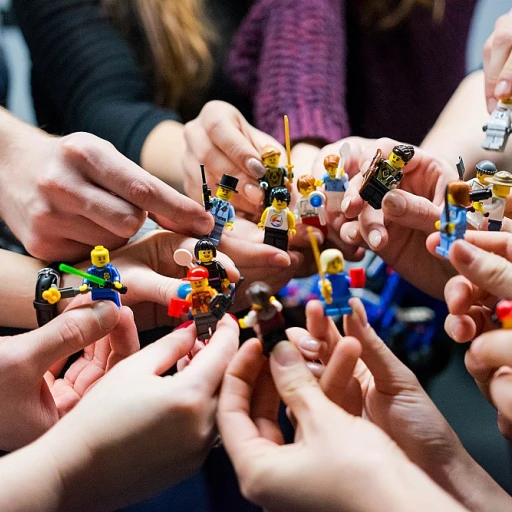Understanding Peer-to-Peer Mentoring
Getting to Know Peer-to-Peer Mentoring
Peer-to-peer mentoring is all about shared learning and growth. It's like having a buddy at work who's just as eager as you are to tackle challenges, share experiences, and celebrate wins. This isn't your typical mentor-mentee setup where wisdom flows top-down from the older to the younger. Instead, it's all about mutual support among equals, regardless of age or experience level.
In most workplace environments, peer mentoring programs thrive when employees actively participate and share their knowledge freely, acting as both mentors and mentees. Not only do these programs enrich individual career paths, but they also build a sense of community within organizations. This nurturing environment leads to better job satisfaction and long-term success for everyone involved.
Even though the concept might sound simple, formal peer mentoring programs are structured and have specific objectives. These programs can be tailored to various organizational needs, be it enhancing technical skills, developing leadership abilities, or facilitating personal growth.
A significant advantage of such a setup is the potential it offers for cross-age interactions. Unlike conventional mentoring, which is often bound by seniority, peer mentorship invites a mix of perspectives that can lead to innovative ideas and solutions. For instance, a younger employee may bring fresh, tech-savvy insights that complement the experience of an older colleague.
Moreover, successful peer mentoring requires a certain level of commitment and trust from both parties. This commitment fosters an open and effective mentoring relationship where peers are not only colleagues but also allies in each other's journey to achieve personal and professional goals.
Want to know more about how peer mentoring can be a journey to success?
Unlocking the Power of Peer Mentoring is a great resource that dives deeper into the benefits and implementation strategies.
The question now is how do you implement such a program effectively? Keep reading to explore insights on overcoming challenges and measuring the impact of peer mentoring in sections to follow.
Advantages of Peer-to-Peer Mentoring
Elevating Professional Growth
Peer mentoring shakes up traditional methods by bringing equals together to share experiences and learn from each other. This approach overthrows the dynamics where one person always calls the shots and turns mentoring into a conversation between partners. Let's explore how this unique mentoring style can boost workplace development.
- Mutual Learning: Peer mentoring shifts the focus between mentor and mentee, allowing both parties to adopt dual roles. This dynamic interaction fosters growth as participants swap stories, share insights, and teach each other new skills.
- Cost-Effective: Since it generally relies on existing employees, implementing a peer mentoring program can be a less expensive alternative compared to external training sessions or mentorship programs that require hiring outside professionals.
- Diverse Perspectives: With individuals from various departments or backgrounds, these mentoring relationships bring diverse perspectives. This enriches the knowledge pool and encourages creative problem-solving, leading to innovative ideas that might not sprout in conventional settings.
- Networking Opportunities: This entire experience creates bonds that may just stay outside the boardroom. By helping peers connect professionally and personally, peer mentoring can lead to a tightly-knit network within the organization, offering long term career support.
- Empowerment and Confidence: The informal structure and non-hierarchical approach of peer mentoring can boost self-assurance. Mentees often feel more inclined to share and seek advice, which in turn helps in developing their leadership and decision-making skills.
While it certainly stirs creativity and confidence, organizations should also be aware of the hurdles ahead. Some may have limited access to expert guidance, and potential informal conversations should not turn into unproductive gossip sessions. *Peer mentoring* has perks that could bring great rewards, but be sure to manage it with clear intentions.
For a deeper connection between professional networks developed through mentorship, explore
this resource.
Challenges in Peer-to-Peer Mentoring
Navigating the Bumps in the Road
Peer-to-peer mentoring certainly brings a lot to the table, but it's not without its hurdles. You'd think that having peers as mentors would always be a smooth process—but think again. Here are some things folks often wrestle with:
- Role Confusion: When both people are on the same level, it can be tricky to understand who's leading the charge in the mentor mentee relationship. Clear boundaries are needed to prevent a 'too many cooks in the kitchen' scenario.
- Reluctant Peers: Sometimes, people are just not interested in being someone's peer mentor. They might think they don't have enough time or worry about not being qualified.
- Lack of Training: Mentors often need guidance on how to be effective. Without proper instruction, the mentoring program may not live up to its potential. Experience from traditional mentoring setups can be beneficial.
- Maintaining Consistency: Commitment becomes an issue if life gets in the way, leading to unfulfilled goals and unmet expectations. Sometimes, life throws curveballs!
All these challenges might make you think about ditching peer mentorship altogether. But don't hit the brakes yet. With proper management and support, these hiccups can be minimized, and the overall rewards far outweigh the initial teething problems.
Effective communication and clear goals from the start establish a healthy mentoring relationship. Those little talks about roles and expectations go a long way, not just as a safety net but also in helping others focus on career improvement and learning.
Peer mentoring programs aren't perfect, but they're a chance for employees to gain skills and knowledge they wouldn't get from just reading a manual. If you're considering setting up your own peer mentoring program, see some
real-life success stories for inspiration.
Implementing Peer-to-Peer Mentoring Programs
Crafting a Successful Peer Mentoring Culture
Implementing a peer mentoring program isn't just about setting things into motion—it's about creating a supportive environment that fosters relationship building and growth. First off, communication is king. Open dialogue between mentors and mentees helps to create a safe space where everyone feels comfortable sharing their experiences and learning from each other.
Another vital step is the identification of specific goals. Both mentors and mentees need to set clear short-term and long-term goals to focus their efforts and measure progress. Goals could relate to learning new skills, acquiring knowledge, or advancing career paths. This clarity of objectives makes the mentoring relationship more structured and focused.
Training and support play critical roles as well. Invest in preliminary training sessions to equip peer mentors with the skills they need to guide their mentees effectively. It’s also beneficial to provide ongoing support and resources throughout the mentoring journey. This helps in maintaining enthusiasm and commitment towards achieving the goals.
While setting up the program, don't forget to promote an inclusive culture. Encourage mentors and mentees to embrace diversity, as this broadens insights and perspectives and enhances learning outcomes for both parties.
Plenty of thought should go into the pairing process, too. Match mentors with mentees based on shared interests, career goals, and compatibility. This careful matchmaking can lay the groundwork for successful mentoring relationships.
Lastly, keep an eye on the feedback loop. Regularly check in with participants to gauge their satisfaction and any areas that might need improvement. Constructive feedback from both mentors and mentees ensures the program remains relevant and effective.
By focusing on these aspects, you can facilitate an effective peer mentoring program that truly benefits employees, helps achieve their aspirations, and promotes a vibrant workplace culture. Peer mentors and mentees standing arm in arm, striving for shared success, symbolize a thriving mentorship culture.
Measuring Success in Peer-to-Peer Mentoring
Tracking Progress and Making Adjustments
Success in peer mentoring programs isn't just about setting them up, but also about keeping an eye on how they're doing and making necessary tweaks. Regular check-ins are essential, both for the mentors and the mentees. They help gauge the development of skills, knowledge sharing, and the overall effectiveness of the mentor-mentee relationship. Are the mentors offering the support their peers need? And are the mentees finding it easy to achieve their goals? These are important questions to consider.
Feedback Mechanisms
A solid mentoring program thrives on feedback. Establishing a feedback loop allows employees to express what’s working and what’s not, which helps improve the quality of the mentoring relationship. Encourage both mentors and mentees to provide insights on their experiences. Whether it's anonymous surveys, regular meetings, or casual chats, having a system to gather real, honest feedback is beneficial. This not only boosts the effectiveness of peer mentorship but also builds trust among participants.
Measurable Outcomes
What gets measured gets managed. Establish clear objectives right at the start. Whether it’s acquiring specific skills, enhancing career growth, or building a strong support network, define what success looks like for your peer mentoring programs. Utilize tools to track progress such as performance metrics, and even personal stories from the participants can provide qualitative insights about the impact of the peer mentoring program.
Success Stories and Best Practices
Real-life successes can be a guiding light. Highlighting stories where employees have transformed their careers through effective peer mentoring can inspire other participants. These success stories serve as testimonials that boost confidence in the mentor program and encourage long-term commitment. Mentors and mentees benefit from learning about various strategies and approaches that have previously worked, helping them in fine-tuning their mentoring relationships. It's all about celebrating wins, big and small!
Remember, the goal of peer mentoring isn't just about imparting knowledge; it's about creating a supportive bond that facilitates continuous learning and personal growth.
Sources:
- Kram, K. E. (1985). Mentoring at work: Developmental relationships in organizational life. Scott Foresman & Company.
- Allen, T. D., & Eby, L. T. (Eds.). (2007). The Blackwell handbook of mentoring: A multiple perspectives approach. John Wiley & Sons.
Real-Life Examples of Successful Peer-to-Peer Mentoring
Successful Stories That Inspire
When you think about peer mentoring, it’s always encouraging to hear the success stories that are out there. These real-life examples aren’t just anecdotes; they’re the heart of what makes peer mentoring so impactful.
Imagine a group of young professionals at a tech company. They decided to form a peer mentoring group to help each other with new programming languages. What started as informal meetups quickly turned into a structured mentoring program where each session built upon the last. The mentors and mentees learned from one another, and within months, they all improved their skills significantly. Their success didn't just stay within the group; it attracted attention from the higher-ups, who began to advocate for more peer mentoring initiatives.
Then there's the example of a healthcare institution where nurse mentors paired up with new recruits in a peer mentoring relationship. The goal was to ease the transition into demanding roles. Not only did it help in reducing stress, but it boosted confidence among the new employees. As they shared knowledge and experiences, the overall atmosphere at work improved, and employee retention rates got a major boost.
In a corporate setup, sales employees took advantage of peer mentorship to share strategies that worked across territories. Junior employees paired with senior mentors to understand the market dynamics better. Such mentoring programs helped in cultivating not just better sales figures, but a culture of continuous learning and support.
Universities have also been a breeding ground for successful peer mentoring stories. Here, senior students offer guidance to incoming freshmen, helping them navigate college life, both academically and socially. This mentorship program helps in forming strong bonds and creates a support system that significantly enhances student life.
These examples highlight the variety of ways that peer mentoring can be implemented successfully, whether it's improving technical skills, boosting confidence, fostering a supportive work culture, or aiding in academic success. Each scenario showcases the real benefits peer programs can bring, proving that when it comes to learning and growing, we can often find the best guidance right alongside us, among peers.










